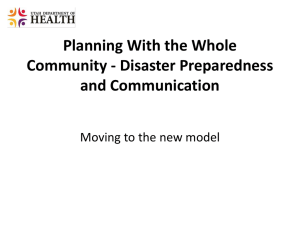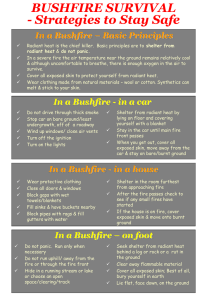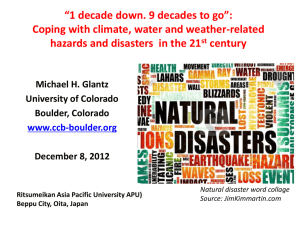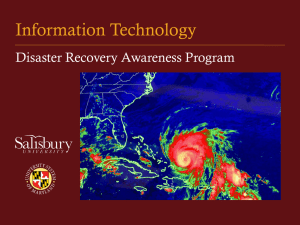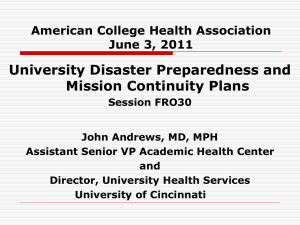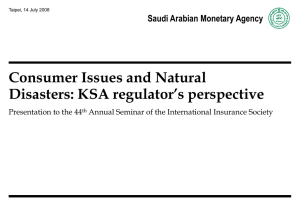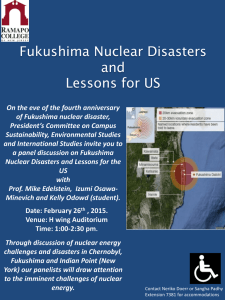Disaster and Disaster Management(1)
advertisement
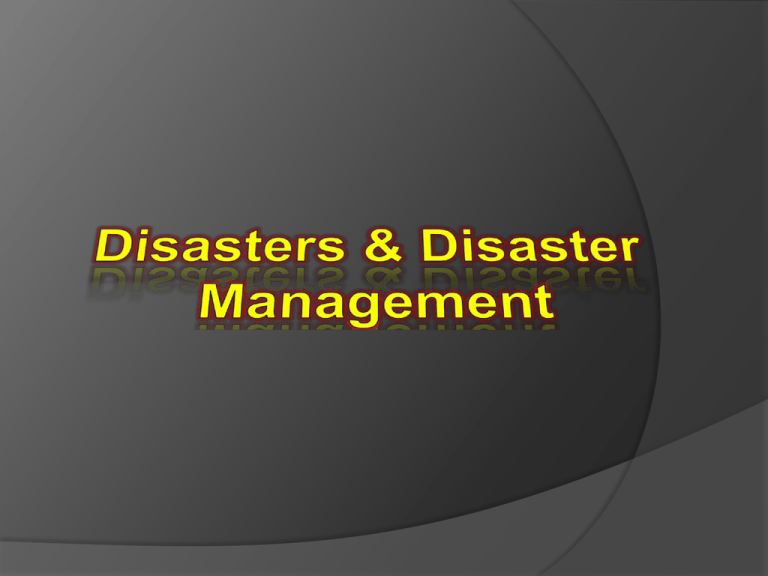
A disaster is a sudden, calamitous event that seriously disrupts the functioning of a community or society and causes human, material, and economic or environmental losses that exceed the community’s or society’s ability to cope using its own resources. Though often caused by nature, disasters can have human origins Disaster Management covers the range of activities designed to maintain control over disasters/emergency situations and to provide a framework for helping people to avoid, reduce the effects of or recover from impact of a disaster. These activities may be related to preparedness, mitigation, emergency response, relief and recovery(reconstruction and rehabilitation) and may be conducted before, during or after a disaster. Disasters can take many different forms, and the duration can range from an hourly disruption to days or weeks of ongoing destruction. There are two types of disasters – man made and natural which can affect a community. Types of Natural Disasters Earthquake An earthquake is the result of a sudden release of energy in the Earth's crust that creates seismic waves. At the Earth's surface, earthquakes manifest themselves by vibration, shaking and sometimes displacement of the ground. The vibrations may vary in magnitude. Earthquakes are caused mostly by slippage within geological faults, but also by other events such as volcanic activity, landslides, mine blasts, and nuclear tests. The underground point of origin of the earthquake is called the focus. The point directly above the focus on the surface is called the epicenter. Earthquakes by themselves rarely kill people or wildlife. Volcanic Eruptions Volcanoes can cause widespread destruction and consequent disaster in several ways. The effects include the volcanic eruption itself that may cause harm following the explosion of the volcano or the fall of rock. Second, lava may be produced during the eruption of a volcano. As it leaves the volcano, the lava destroys many buildings and plants it encounters. Third, volcanic ash generally meaning the cooled ash - may form a cloud, and settle thickly in nearby locations. When mixed with water this forms a concrete-like material. In sufficient quantity ash may cause roofs to collapse under its weight but even small quantities will harm humans if inhaled. Since the ash has the consistency of ground glass it causes abrasion damage to moving parts such as engines. Volcanic Eruptions Hydrological Disasters It is a violent, sudden and destructive change either in quality of earth's water or in distribution or movement of water on land below the surface or in atmosphere. Types of Hydrological Disasters Floods A flood is an overflow of an expanse of water that submerges land. The EU Floods directive defines a flood as a temporary covering by water of land not normally covered by water.[In the sense of "flowing water", the word may also be applied to the inflow of the tide. Flooding may result from the volume of water within a body of water, such as a river or lake, which overflows or breaks levees, with the result that some of the water escapes its usual boundaries. While the size of a lake or other body of water will vary with seasonal changes in precipitation and snow melt, it is not a significant flood unless the water covers land used by man like a village, city or other inhabited area, roads, expanses of farmland, etc. Floods Limnic Eruptions A limnic eruption occurs when a gas, usually CO2, suddenly erupts from deep lake water, posing the threat of suffocating wildlife, livestock and humans. Such an eruption may also cause tsunamis in the lake as the rising gas displaces water. Scientists believe landslides, volcanic activity, or explosions can trigger such an eruption. Lumnic Eruptions Tsunami Tsunamis can be caused by undersea earthquakes as the one caused by the 2004 Indian Ocean Earthquake, or by landslides such as the one which occurred at Lituya Bay, Alaska. Tsunamis Meteorological Disasters Types of Meteorological Disasters Blizzards Blizzards are severe winter storms characterized by heavy snow and strong winds. When high winds stir up snow that has already fallen, it is known as a ground blizzard. Blizzards can impact local economic activities, especially in regions where snowfall is rare. Cyclonic Storms Types of Cyclonic Storms Tropical Cyclones Cyclone, tropical cyclone, hurricane, and typhoon are different names for the same phenomenon a cyclonic storm system that forms over the oceans. The deadliest hurricane ever was the 1970 Bhola cyclone; the deadliest Atlantic hurricane was the Great Hurricane of 1780which devastated Martinique, St. Eustatius and Barbados. Another notable hurricane is Hurricane Katrina which devastated the Gulf Coast of the United States in 2005. Extra tropical Cyclones Extra tropical cyclones, sometimes called midlatitude cyclones, are a group of cyclones defined as synoptic scale low pressure weather systems that occur in the middle latitudes of the Earth (outside the tropics) not having tropical characteristics, and are connected with fronts and horizontal gradients in temperature and dew point otherwise known as "baroclinic zones". As with tropical cyclones, they are known by different names in different regions (Nor'easter, Pacific Northwest windstorms, European windstorm, East Asian-northwest Pacific storms, Sudestada and Australian east coast cyclones). Cyclones Droughts Drought is unusual dryness of soil, resulting in crop failure and shortage of water for other uses, caused by significantly lower rainfall than average over a prolonged period. Hot dry winds, high temperatures and consequent evaporation of moisture from the ground can contribute to conditions of drought. Droughts Hailstorms Hailstorms are falls of rain drops that arrive as ice, rather than melting before they hit the ground. A particularly damaging hailstorm hit Munich, Germany, on July 12, 1984, causing about 2 billion dollars in insurance claims. Hail Storms Heat Waves A heat wave is a period of unusually and excessively hot weather. The worst heat wave in recent history was the European Heat Wave of 2003. A summer heat wave in Victoria, Australia, created conditions which fuelled the massive bushfires in 2009. Melbourne experienced three days in a row of temperatures exceeding 40°C (104°F) with some regional areas sweltering through much higher temperatures. The bushfires, collectively known as "Black Saturday", were partly the act of arsonists. Heat Waves Tornadoes A tornado is a violent, dangerous, rotating column of air that is in contact with both the surface of the earth and a cumulonimbus cloud or, in rare cases, the base of a cumulus cloud. It is also referred to as a twister or a cyclone, although the word cyclone is used in meteorology in a wider sense, to refer to any closed low pressure circulation. Tornadoes come in many shapes and sizes, but are typically in the form of a visible condensation funnel, whose narrow end touches the earth and is often encircled by a cloud of debris and dust. Most tornadoes have wind speeds less than 110 miles per hour (177 km/h), are approximately 250 feet (80 m) across, and travel a few miles (several kilometers) before dissipating. The most extreme tornadoes can attain wind speeds of more than 300 mph (480 km/h), stretch more than two miles (3 km) across, and stay on the ground for dozens of miles (perhaps more than 100 km). Tornadoes Man Made disasters is a disaster resulting from human intent, negligence or error. The results are usually wide scale destruction and high costs. Oil spills and arson are examples of man made disasters. A bushfire is a fire that burns in grass, bush or woodland and can threaten life, property and the environment. These can be due to arson or extreme climate. Bushfires tend to occur when light and heavy fuel loads in Eucalypt forests have dried out. The potential for extreme fire weather varies both in frequency and severity. When potential extreme fire weather is experienced close to populated areas, significant loss is possible. Most loss of life and economic damage occurs around the fringes of cities where homes are commonly in close proximity to flammable vegetation. The basic factors which determine whether a bushfire will occur include the presence of fuel, oxygen and an ignition source. More specifically, fire intensity and the speed at which a bushfire spreads will depend on ambient temperature, fuel load, fuel moisture, wind speed and slope angle. Fuel load The greater the fuel load, the hotter and more intense the fire. Fuel which is concentrated with adequate spacing will burn faster than heavily compacted or scattered fuel sources. Smaller pieces of fuel such as twigs litter and branches burn quickly, particularly when they are dry and loosely arranged. Some types of grasses burn very rapidly, while larger fuels, such as tree trunks, do not burn as easily. The natural oil within Eucalypt trees promotes the combustion of fuel. Fuel moisture Dry fuel will burn quickly, but damp or wet fuel may not burn at all. As a consequence, the time since rainfall and the amount of rain received is an important consideration in assessing bushfire danger. Often a measure of the drought factor, or moisture deficit, will be used as an indicator of extreme bushfire weather conditions. Wind speed Wind acts to drive a fire by blowing the flames into fresh fuel, bringing it to ignition point and providing a continuous supply of oxygen. Wind also promotes the rapid spread of fire by spotting, which is the ignition of new fires by burning embers lofted into the air by wind. Ambient temperature The higher the temperature the more likely it is that a fire will start or continue to burn. This is because the fuel is closer to its ignition point at high temperatures and pre-heated fuel loads burn faster. Humidity Dry air promotes a greater intensity fire than moist air. Plants become more flammable at a low humidity because they release their moisture more easily. Slope angle Fires pre-heat their fuel source through radiation and convection. As a consequence of these heat transfer effects, fires accelerate when travelling uphill and decelerate travelling downhill. The steepness of the slope plays an important role in the rate of fire spread. The speed of a fire front advancing will double with every 10 degree increase in slope so that on a 20 degree slope, its speed of advance is four times greater than on flat ground. Bushfires happen every summer, they can start suddenly and without warning. People have been killed or seriously injured, and homes destroyed during bushfires. The devastating impact a bushfire has on a community has a lasting affect and can take years to recover from. Even if you live in a metropolitan area near bushland, then bushfire is a real threat to you, your family and property. You need to understand the bushfire risk to your family and home so you can make decisions now about what you will do if a bushfire starts. Here you will find essential information and advice to assist you to Prepare. Act. Survive. Prepare your family, home or business. Know your bushfire risk and develop a bushfire survival plan. Act on the fire danger ratings. Put your preparations into action, do not wait and see. Survive by monitoring conditions if a fire starts. Know the bushfire warning alert levels and what you will do if you are caught in a fire. 1. 2. Disaster Strikes: Andhra Pradesh the fifth largest state of India, was severely battered by cyclonic storm with a wind speed of over 200 Kmph on 15th November, 1977 killing more than 10,000 lives and leaving more than 50,000 people homeless. A large number of people mainly the fishing community lost their livelihood. The total economic loss was around 3.78 billion rupees. Emergency Response & Relief: Immediately after government, community and NGO’s extended relief to those affected. This included search and rescue, provision of food, clothing, shelter and medicine to those affected. 3. Rehabilitation and Reconstruction: Soon after the initial response and relief phase, rehabilitation and reconstruction initiatives were taken up by the Government, NGO’s like construction of houses, roads and bridges, restoration of power and communication. This also included economic rehabilitation through livelihood support 4. Mitigation: Implementation of effective preparedness and mitigation measure can reduce the adverse impact of disasters. Mitigation measures include promoting mangrove plantation, relocation of villages to safer lands, practicing and promoting cyclone resistant construction techniques. 5. 6. Preparedness: Soon after the cyclone, emphasis was laid on community preparedness measures which were carried out by the government/NGOs. Village Disaster Management Teams were formulated and trained and a large number of cyclone shelters & mounds were constructed in strategic locations so as to accommodate villagers in case another cyclone strikes that area. In 1990, Andhra Pradesh was struck by another severe cyclone. Though the impact on the houses were greater than 1977 due to increased population, the number of casualties was far less because of effective mitigation preparedness measures. These phases are normally carried out simultaneously after a disaster. As soon as a disaster strikes a locality, immediate response and relief activities are carried out by the government, NGO’s, various religious bodies. This includes search and rescue of those affected, First Aid, provision of food, clothing, shelter, medicine to those affected etc. Soon after the initial response and relief phase, rehabilitation and reconstruction initiatives are taken up by the government, NGOs and various other agencies which would help the affected community to come back to normalcy. Roads, permanent houses, power and communication networks are restored. This phase of disaster management also includes economic rehabilitation for those who have lost their livelihood. As long term measures to reduce the impact of the disasters, various structural and non-structural initiatives are taken up. Some of the structural measures include construction of disaster resistant buildings, raising the river embankments etc and some non-structural measures include raising awareness and preparation of plans at the community level for better preparedness. These measures are termed as mitigation measures. If effective preparedness measures are taken into account, the impact of the disasters can be reduced to a large extent and the community is better equipped to combat disasters. National Disaster Response Force The National Disaster Response Force (NDRF) is a disaster response agency under National Disaster Management Authority (NDMA) created by the Ministry of Home Affairs, government of India. It was established in 2009 in Delhi, for disaster management and specialized response to natural and manmade disasters. Functioning at state and central-level under the NDMA based in Delhi, it consists of eight battalions of Indian Armed forces, including two each of the BSF, CRPF, CISF and ITBP. National Disasters Response Force

